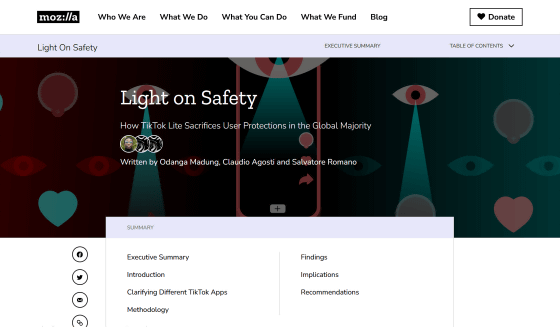'TikTok Lite' targeted at developing countries has no labels for AI-generated content or misinformation and has inferior safety measures than the regular version

Major technology companies not only release standard apps that are mainly available in developed countries, but also lightweight apps that are small in size and require lower device performance for developing countries. ByteDance, which operates TikTok, also offers a lightweight version of TikTok called 'TikTok Lite.' However, investigations by Mozilla and others have revealed that TikTok Lite lacks some of the user protection features present in the standard version, putting users at risk.
Light on Safety - Mozilla Foundation

Study: TikTok Lite is a 'safety hazard' for millions of users around the world | ZDNET
https://www.zdnet.com/article/study-tiktok-lite-is-a-safety-hazard-for-millions-of-users-around-the-world/
For technology platforms that want to establish an international presence, it is important to acquire a user base not only in developed countries, mainly in the United States and Europe, but also in developing countries in South America, Asia, and Africa. However, users in developing countries cannot afford to own cutting-edge devices for economic reasons, and often use cheap or second-hand products with inferior performance, and the Internet environment is often inadequate. Therefore, even if you deploy something that is intended for use in developed countries, it can be difficult to acquire users because it is not comfortable to use.
Therefore, some technology companies have adopted a strategy of releasing lightweight versions of their apps for developing countries to gain a user base. ByteDance has also adopted this strategy, and TikTok Lite, which is deployed in developing countries, has a smaller app size, less battery usage, and lower data consumption compared to the regular version of TikTok. TikTok Lite, which was first launched in Thailand in 2018, has been downloaded about 1 billion times on the Google Play Store and is estimated to account for nearly half of TikTok's user base.
In addition, an app called ' TikTok Lite ' has been released in Japan, but this is a different app from the one released in developing countries. This time, Mozilla and other teams investigated ' TikTok Lite - Save Data ', which is released for developing countries, rather than TikTok Lite, which is available in Japan.
The research team investigated whether the safety features of the regular version of TikTok, such as 'labeling' and 'user control,' were also included in the version of TikTok Lite released in Kenya, Uganda, South Africa, and Chile. The findings of the report are current as of Friday, July 19, 2024. As a result of the investigation, it was found that many of the safety features included in the regular version of TikTok were not present in TikTok Lite released for developing countries. Specifically, the following features were missing in TikTok Lite.
- Labeling dangerous activities
Dangerous challenges such as the ' fainting challenge ' and the ' skull-shattering challenge ' have frequently gone viral on TikTok, and each time they have faced public criticism and scrutiny from regulatory agencies. Therefore, the regular version of TikTok has a 'dangerous activity label' on videos that may be dangerous to users and warns them.
However, the lightweight version of TikTok does not have this 'labeling of dangerous activities.' Looking at the image below, you can see that the warning label on the regular version of TikTok (left) is not on TikTok Lite (right).

- Opt-in screen for sensitive content
TikTok's guidelines state that opt-in screens and warning information

Labeling misinformation and bannering sources
Like other online platforms, TikTok has been in the spotlight for its handling of misinformation, mainly around health and politics. To combat this, the standard version of TikTok includes safety features such as labeling videos that deal with sensitive topics like elections and the pandemic and providing links to reliable sources. But Mozilla points out that these features are missing or inadequate in TikTok Lite.

・Labeling AI-generated content
Generative AI poses the risk of misleading users and promoting the spread of misinformation at important times such as elections and disasters. TikTok is also aware of the risks inherent in generative AI and is encouraging creators to label content that uses generative AI. However, it is said that labeling of generative AI content cannot be confirmed on TikTok Lite.

- Omission of explanatory text
Videos posted on TikTok have a description section, where video creators can explain the context, hashtags, messages to users, etc. However, in TikTok Lite, the text displayed is automatically shortened and creators cannot control it.

Lack of user control
In the regular version of TikTok, users can control 'filtering malicious comments,' 'content settings that do not display videos that may not be suitable for some viewers,' 'management of screen time,' etc., making TikTok safer to use. However, TikTok Lite does not have these user controls, which may put users at risk.

In response to the findings of this investigation, Mozilla and others pointed out that TikTok Lite, which is less secure than the regular version, is being deployed in developing countries, increasing the risk of users being exposed to harmful content and becoming addicted to the app. They called on ByteDance to make improvements such as 'adding labels and banners' and 'strengthening user controls,' saying that these improvements can be implemented without significantly increasing bandwidth and power consumption.
Related Posts:
in Mobile, Web Service, Posted by log1h_ik







